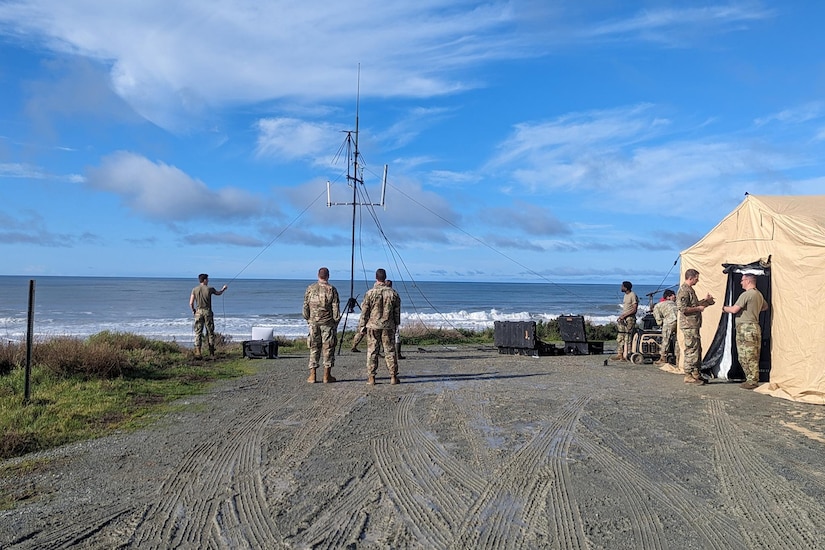AUKUS, the trilateral security agreement among Australia, the United Kingdom and the United States, is already bringing the three allies closer together, and concrete progress will be measured over the next few years, the chiefs of the countries’ land forces said yesterday at a Center for Security and International Studies presentation.
AUKUS, signed in September 2021, is primarily known as a program that will enable the three countries to work together to provide a nuclear-powered, conventionally armed submarine force to Australia in the 2040s. This is the “Pillar 1” portion of the program, but leaders from all domains are already working on Pillar 2 of the agreement. Army leaders speaking at CSIS said they can see the benefits of the close partnership happening much more quickly.
Pillar 2 looks at technologies — including hypersonic weapons, cyber and computer technology and more — and land forces have expertise in these capabilities.
Australian Chief of Army Lt. Gen. Simon Stuart, British Army Chief of the General Staff Gen. Sir Patrick Sanders, and U.S. Army Chief of Staff Gen. Randy A. George have worked closely together to examine the ramifications of the partnership and ways to make it closer and more interoperable.
“In an era of great power competition, defense and security is once again, a whole of nation endeavor,” Stuart said. “But even more so, it requires us to work even more closely and in a more integrated fashion with allies and partners. As military professionals, our greatest challenge is balancing the enduring human nature of warfare with its ever-changing character.”
The three men have been meeting for a week and observed exercises at Camp Pendleton, California. The other two land force chiefs echoed Stuart’s statements.
The leaders see Russia’s war on Ukraine and conflict in the Middle East and see lessons for their own militaries and the need for closer cooperation among the militaries. In the past, George said, the military would see a promising technology or system and examine it and, perhaps, get it on line in four or five years. “We have to be quicker than that,” he said. “What we talk about in the U.S. Army is continuous transformation.”
He used lessons from unmanned aerial vehicles in Ukraine as an example. “You really can’t hide anymore with all the sensors that you have out there,” he said. “That has implications for … how we’re going to have to transform.”
He noted that commercial companies are moving much quicker than the military in many areas, and the three leaders had conversations about the process.
Other aspects they spoke about were that more people are moving to cities and combat is moving to cities, as well. “That will have implications on … what your capabilities are and how you’re going to do those things,” he said.
The meeting of the land forces chiefs is timely, as the world situation is volatile, Sanders said. “We can see threats proliferating, at a scale, a pace and a vector that we probably haven’t seen for 80 years or more,” the British chief said. “It’s not beyond the realms of possibility that these threats begin to metastasize together.”
The meetings are also key as time is “surely the most critical strategic resource that we have in the face of these threats,” he continued.
Sanders said he sees the discussions as a chance to speak about deterrence, which includes maintaining and increasing capabilities – what he calls “magazine depth.”
AUKUS, he said, is about maintaining the warfighting competitive edge. “It’s about partners” being able to seamlessly work together.
To that point, Stuart said that the chiefs spent a lot of time discussing the need for U.S., Australian and British forces to share data at machine speed. “You need to get the right data in the right place at the right classification,” he said. “If we were to look at what some of the central priorities are, I think what we would previously have called the network is really at the heart of the of digital age warfare in all domains, but particularly in the land domain.”
Data is the key, Sanders said. Data ultimately generates effects, and that requires “being able to freely flow data from sensors through to deciders through to effectors across all domains,” he said. ” is the single most important enabler to allow us to co-develop, co-produce and co-sustain the sort of capabilities that were, that we’re talking about.”
There is a lot of blue in any map of the Indo-Pacific, and many believe AUKUS is a maritime strategy. George said people must think larger than that. “You’re not going to win a war from the sea,” he said. “I don’t think you’re going to win a war from the air. I’m certainly not saying that you would win just from the land.
“I think that there’s no such thing as a maritime theater, for example, I think these are joint theaters,” he continued. “It’s going to take everybody’s capability. It’s going to have to be a joint team.”









